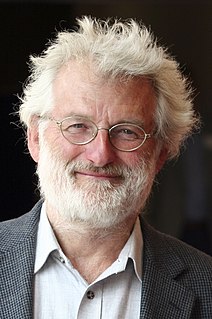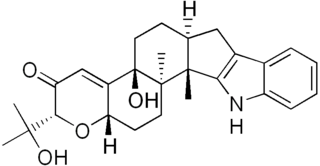Related Research Articles

Caenorhabditis elegans is a free-living, transparent nematode, about 1 mm in length, that lives in temperate soil environments. It is the type species of its genus. The name is a blend of the Greek caeno- (recent), rhabditis (rod-like) and Latin elegans (elegant). In 1900, Maupas initially named it Rhabditides elegans, Osche placed it in the subgenus Caenorhabditis in 1952, and in 1955, Dougherty raised Caenorhabditis to the status of genus.

The Pleurothallidinae are a neotropical subtribe of plants of the orchid family (Orchidaceae) including 29 genera in more than 4000 species.
Yolanda may refer to:
Howard Robert Horvitz is an American biologist best known for his research on the nematode worm Caenorhabditis elegans, for which he was awarded the 2002 Nobel Prize in Physiology or Medicine, together with Sydney Brenner and John E. Sulston.

Sir John Edward Sulston was a British biologist and academic who won the Nobel Prize in Physiology or Medicine for his work on the cell lineage and genome of the worm Caenorhabditis elegans in 2002 with his colleagues Sydney Brenner and Robert Horvitz. He was a leader in human genome research and Chair of the Institute for Science, Ethics and Innovation at the University of Manchester. Sulston was in favour of science in the public interest, such as free public access of scientific information and against the patenting of genes and the privatisation of genetic technologies.

The spermatheca, also called receptaculum seminis, is an organ of the female reproductive tract in insects, e.g. bees, some molluscs, oligochaeta worms and certain other invertebrates and vertebrates. Its purpose is to receive and store sperm from the male or, in the case of hermaphrodites, the male component of the body. Spermathecae can sometimes be the site of fertilization when the oocytes are sufficiently developed.

Rosellas are in a genus that consists of six species and nineteen subspecies. These colourful parrots from Australia are in the genus Platycercus. Platycercus means "broad-tailed" or "flat-tailed", reflecting a feature common to the rosellas and other members of the broad-tailed parrot tribe. Their diet is mainly seeds and fruit.

The blue-tailed damselfly or common bluetail is a damselfly, belonging to the family Coenagrionidae.

Elmisaurus is an extinct genus of dinosaur from the Late Cretaceous. It was a theropod belonging to the Oviraptorosauria. Its fossils have been found in Mongolia. It is known from foot and hand bones.

The ring-tailed vontsira, locally still known as the ring-tailed mongoose is a euplerid in the subfamily Galidiinae, a carnivoran native to Madagascar.

In molecular biology lin-4 is a microRNA (miRNA) that was identified from a study of developmental timing in the nematode Caenorhabditis elegans. It was the first to be discovered of the miRNAs, a class of non-coding RNAs involved in gene regulation. miRNAs are transcribed as ~70 nucleotide precursors and subsequently processed by the Dicer enzyme to give a 21 nucleotide product. The extents of the hairpin precursors are not generally known and are estimated based on hairpin prediction. The products are thought to have regulatory roles through complete or partial complementarity to mRNA. The lin-4 gene has been found to lie within a 4.11kb intron of a separate host gene.

The Wyoming ground squirrel is a species of rodents in the family Sciuridae.

The elegant water shrew is a species of mammal in the subfamily Soricinae of the family Soricidae. It is monotypic within the genus Nectogale. It lives in Sikkim and China.

Eudromia is a genus of birds in the tinamou family. This genus comprises two crested members of this South American family.
Cornelia Isabella "Cori" Bargmann is an American neurobiologist. She is known for her work on the genetic and neural circuit mechanisms of behavior using C. elegans, particularly the mechanisms of olfaction in the worm. She has been elected to the National Academy of Sciences and had been a Howard Hughes Medical Institute investigator at UCSF and then Rockefeller University from 1995 to 2016. It was announced on September 21, 2016 that she had been named the incoming president of science at the Chan Zuckerberg Initiative, effective October 1, 2016. In 2012 she was awarded the $1 million Kavli Prize, and in 2013 the $3 million Breakthrough Prize in Life Sciences.

The western terrestrial garter snake is a western North American species of colubrid snake. At least five subspecies are currently recognized.

Paxilline is a potassium channel blocker. Paxilline is a toxic, tremorgenic indole alkaloid produced by Penicillium paxilli . Paxilline was found to significantly extend the lifespan healthspan and mobility of C. elegans aged worms, but had no such effect on young worms.
In molecular biology mir-84 microRNA is a short RNA molecule. MicroRNAs function to regulate the expression levels of other genes by several mechanisms.
WormBase is an online biological database about the biology and genome of the nematode model organism Caenorhabditis elegans and contains information about other related nematodes. WormBase is used by the C. elegans research community both as an information resource and as a place to publish and distribute their results. The database is regularly updated with new versions being released every two months. WormBase is one of the organizations participating in the Generic Model Organism Database (GMOD) project.
Bauruemys is an extinct genus of turtles in the family Podocnemididae.
References
- ↑ Luer & Hirtz, Orchidee (Hamburg) 37: 23 (1986)